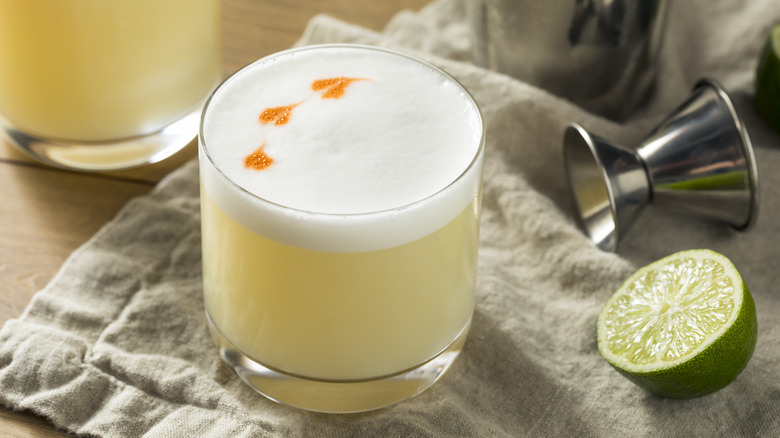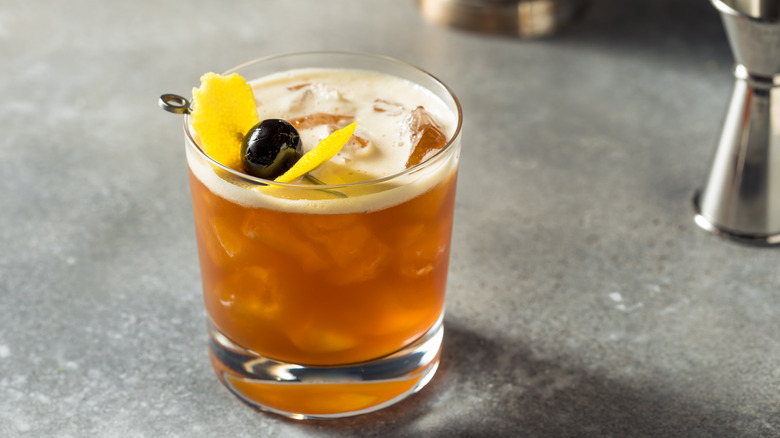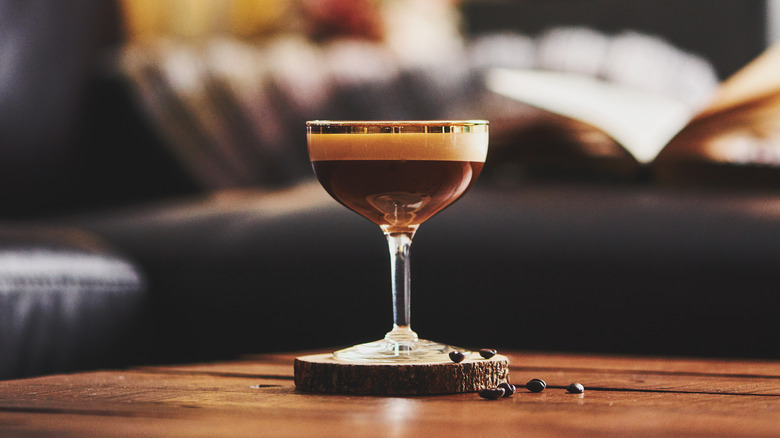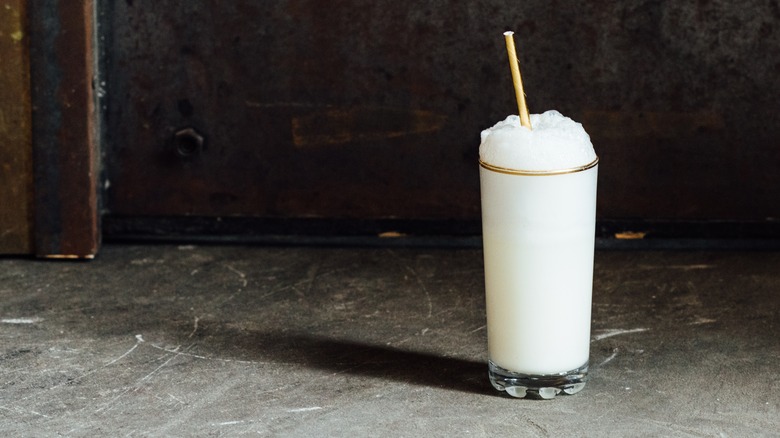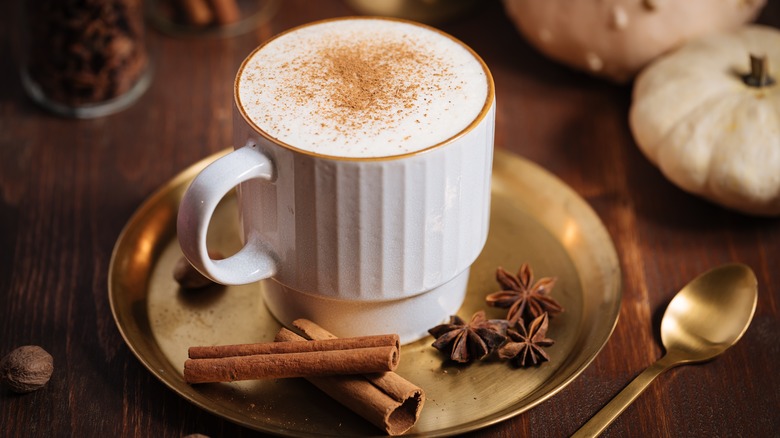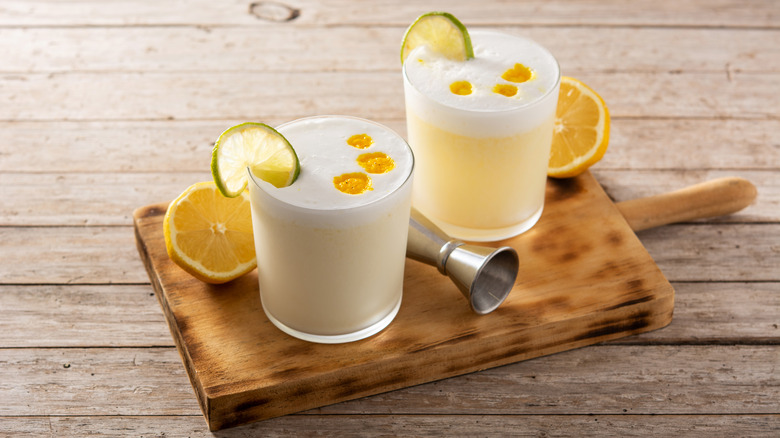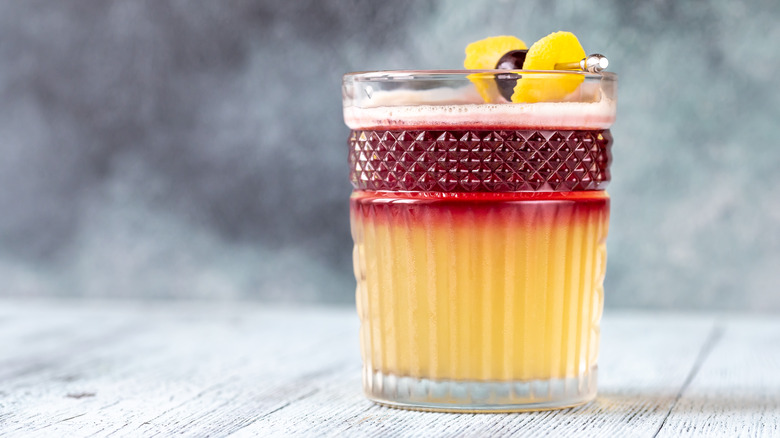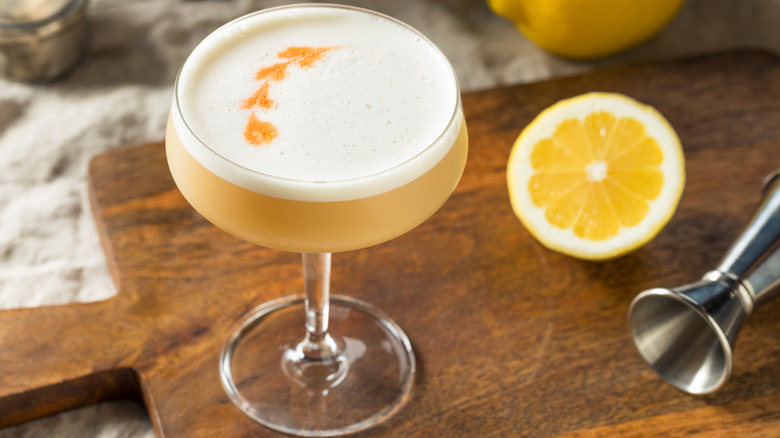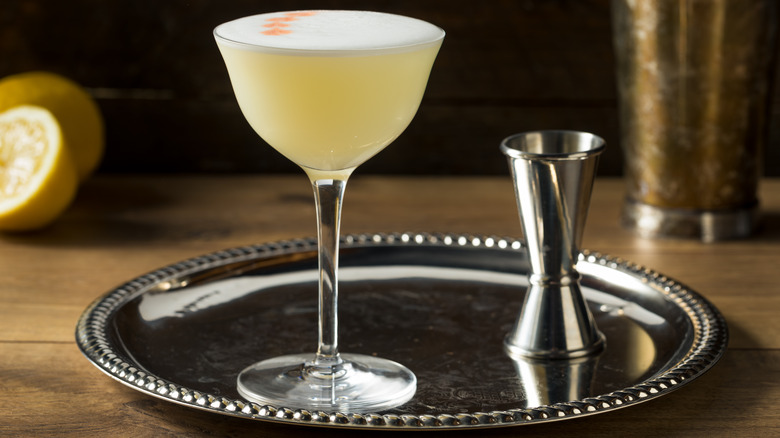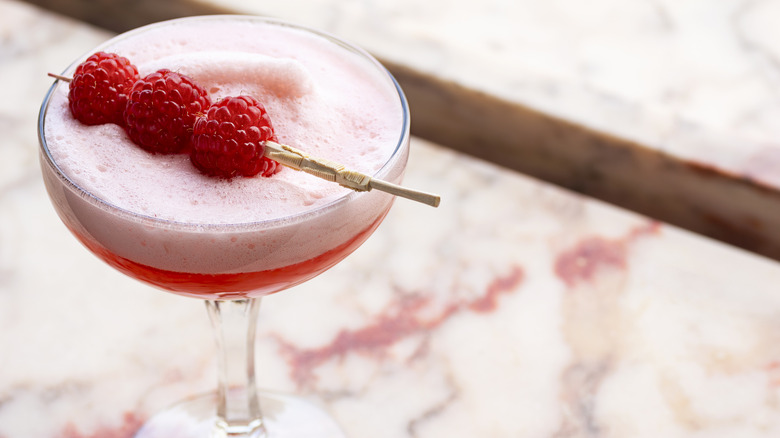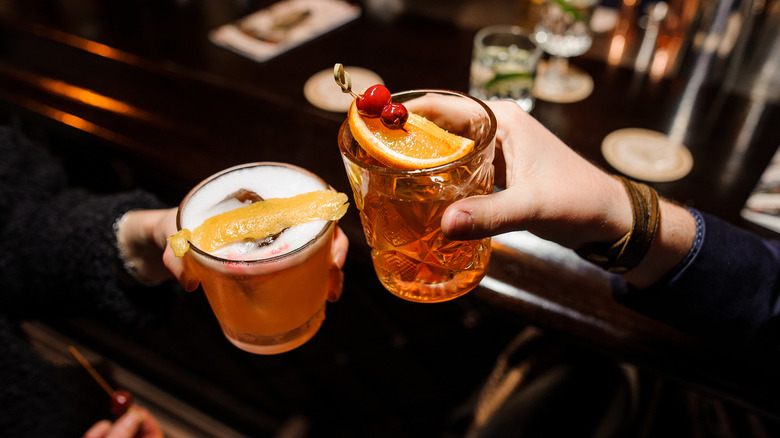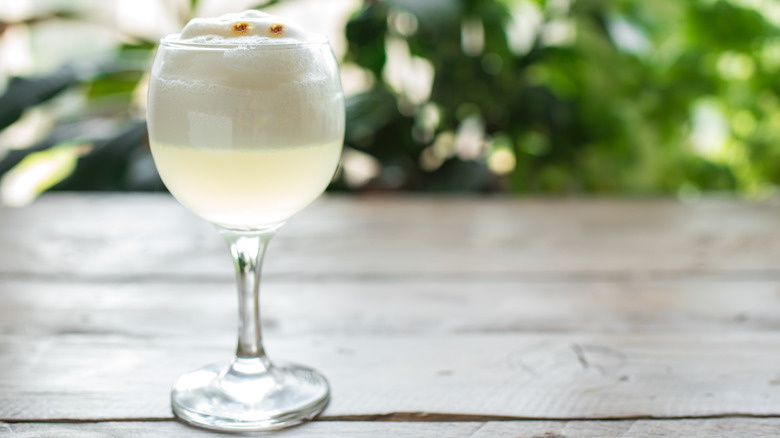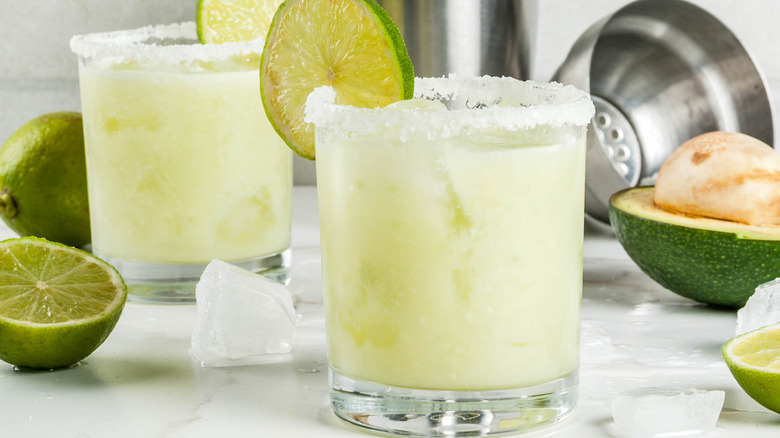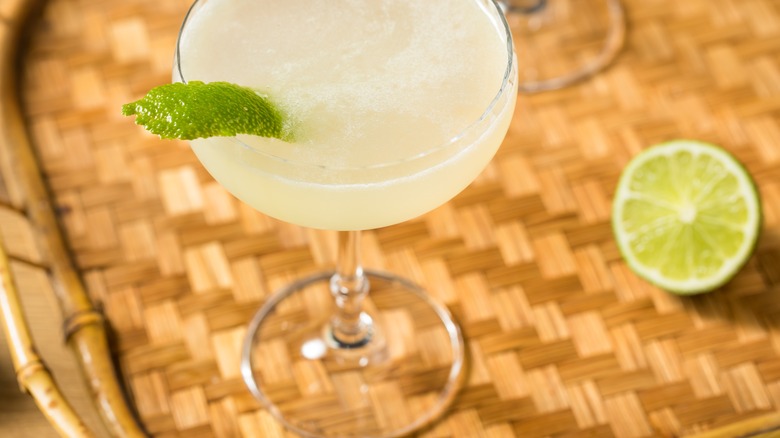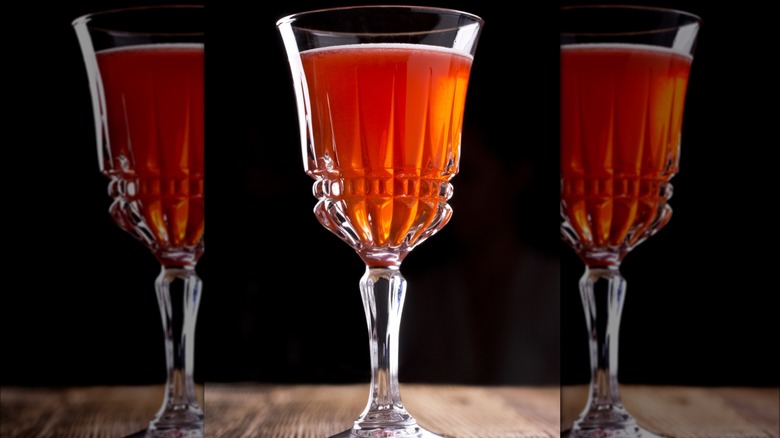14 Egg White Cocktails For Classic, Frothy Fun
A balanced cocktail doesn't only rely on flavor; the texture is important to creating the perfect drink. Cocktails usually balance the sweetness of syrups, sourness of citrus, and unique flavors of spirits. However, add egg whites with these elements, and you'll have a silky, frothy cocktail that creates a complex finish pleasing to the mouth.
Mixologists, bartenders, and amateur drinkers around the globe have experimented with other elements to add to the unique flavor and texture of egg white cocktails. The creamy texture the ingredient gives drinks makes it a versatile element, used in anything needed for a frothy, velvety feel.
From fizzes, nogs, and everything in between, egg whites bring cocktails to another level. The ingredients have been mixed into drinks for centuries and are usually paired with berries, citrus, and some type of sugar to create a balanced cocktail. Here are 15 beverages that embrace egg white's airy texture, from medieval Britain to modern twists.
Amaretto Sour
Amaretto Sour is often given a bad wrap, known for its sweetness and "weak" alcohol content. However, it's a classic cocktail that deserves a try when made with fresh ingredients, not an overly sugary sweet-and-sour mix.
Amaretto, meaning "a little bitter" in Italian, is an almond-flavored liqueur. Brands use all kinds of ingredients to give this spirit the distinct bitter flavor, from the original almond to peach stones or kernels of apricots. Besides the bitter taste, there are notes of dark cherry in Amaretto, which takes away some of the harshness of the almond flavor.
This flavor combination pairs exceptionally well with fresh sour ingredients. The cocktail is a mix of freshly squeezed lemon juice, a small dollop of simple syrup, and finally, egg whites to create the frothy texture. The cocktail is dry-shaken for at least 15 seconds, then chilled before being strained into a rocks glass.
Finally, the cocktail is garnished with dark, tart cherries to bring out the subtle cherry notes from the Amaretto.
Espresso Bourbon Fizz
Besides the most common style of egg white cocktail (the sour) the fizz is the second most popular but just as delicious. In the last few years, espresso has been a unique ingredient incorporated into a variety of cocktails. The toasted, chocolatey notes of this strong coffee pair perfectly with the smokey, vanilla flavor of bourbon. These two main ingredients are added with simple syrup and egg whites and given a good shake. Finally, the cocktail is topped with a splash of soda water.
The result? A sweet, slightly smokey, foamy, delightful cocktail — the frothy richness from egg whites and subtle carbonation give a refreshing note to this beverage.
The best part about the Espresso Bourbon Fizz is its versatility. Coffee and bourbon are the main elements, but the sweetener can be brown sugar, maple syrup, or even coffee simple syrup. You can also add a dash of vanilla that will accentuate the flavor of the bourbon so much you'll never go back to vodka!
Ramos Gin Fizz
A staple cocktail of New Orleans, this creamy drink combines gin, simple syrup, heavy cream, lemon and lime juice, orange flower water, and egg whites, shaken for at least three minutes and strained, and finally topped with soda water.
Invented by Henry C. Ramos in 1888, the drink became so popular throughout New Orleans that Ramos had to hire 20 bartenders, who constantly shook up this cocktail. The drink didn't hit the rest of the country until 1935 when then-Senator Huey P. Long brought his own bartender from New Orleans to make the cocktail as part of a publicity stunt while he was campaigning against Roosevelt's New Deal.
Like many egg white-based drinks, ordering a Ramos Gin Fizz at a busy bar will likely get you an eye-roll at the minimum and an escort out in the extreme. The drink involves several ingredients to mix, then at least three minutes to shake to reach the height of creaminess a good Ramos Gin Fizz requires.
But when ordered and done right, a perfect Ramos Gin Fizz has a thick, velvety foam topping off the citrus, gin, and subtle orange flower flavors. In a city famous for its cocktails, it's one of New Orleans's best.
Eggnog
There's nothing like a glass of eggnog during the holidays — something about the creamy texture balancing the rum, nutmeg, and cinnamon that brings a warm, nostalgic feeling. This classic holiday cocktail gets its creaminess from the combination of egg and milk. Though creating this holiday beverage does take some cooking, you can make large batches of this for your next holiday get-together.
Eggnog is thought to originate from "posset," a medieval British drink made from eggs, figs, and sherry or ale. Once it arrived in the United States, people started incorporating common ingredients at the time, adding in milk and substituting the sherry for rum.
The cocktail made its way through American history and was eventually consumed during Christmas. Even George Washington got his hands in some recipe concocting, creating his own ridiculously boozy version of eggnog, including rum, whisky, and sherry.
The sugary supermarket versions shouldn't be the only eggnog you've tried. You haven't experienced real eggnog if it isn't homemade at a Christmas party or made batched at your local cocktail bar.
Spiced rum is a perfect spirit for this cocktail, pairing well with winter spices like cinnamon and nutmeg. The milk and egg whites, of course, create the silky body of this cocktail and balance out the spiciness of the other ingredients. Cheers!
Pisco Sour
Pisco's roots are a highly-contentious and debated topic, with Chile and Peru both claiming to be the originators of this unique spirit. The spirit is similar to Grappa because it's made from leftover grape juices, musts, and stems, but the taste is more similar to tequila.
The Pisco Sour's origins, though, are thought to be in Lima, Peru, around 1915. Victor Morris, an American living and bartending in Lima to make a living during prohibition, blended this spirit with lime juice, egg whites, and Angostura bitters.
The cocktail is first dry-shook, meaning the ingredients are shaken without ice so the elements can incorporate without diluting with melted water, as egg whites need to be shaken for some time. Then, the mixture is shaken briefly again with ice to chill. And voila! A balanced cocktail, with the sharp pisco flavor softened by the sweetness of the simple syrup, enhanced with the acidic citrus of lime juice — and finally garnished with Angostura bitters on top of the egg whites' creamy, fluffy texture.
New York Sour
Inspired by the Whiskey Sour (like so many egg white-based cocktails), the New York Sour transforms this traditional American cocktail by adding a fruity red wine floater to the top. Despite its simplicity, the New York Sour is both delicious and aesthetically pleasing.
The cocktail, ironically, is thought to be invented in Chicago in the mid-19th century, though the history is vague. However, when the cocktail was introduced in New York, it took off, and New Yorkers claimed the cocktail as their own.
New York Sours offer an accessible cocktail that pleases both those who love classic whiskey sour and those who are intimidated by the strong whiskey flavor. The "float" of fruity red wine can vary in size, depending on which camp you're in. Add in a generous pour if you're not a fan of whiskey, or give a conservative splash if you just want the fruity notes on your nose rather than overpowering the taste.
Though the egg whites are optional, it's simply not a sour without the frothy head this ingredient gives the cocktail.
Orange Creamsicle Cocktail
Orange Creamsicle is a taste synonymous with summer. There's nothing like the nostalgia of running after the neighborhood ice cream truck, ordering this delicious orange and vanilla bar, and rushing to finish it before it melts into your hands.
Though this cocktail sounds like it would be intimidating to make, there are only five common ingredients. Mix vodka, egg whites, and orange juice with vanilla, the key ingredient that makes it taste like a creamsicle, for your creamy cocktail base. Though the Orange Creamsicle Cocktail has all the ingredients of a sour, it is very sweet and strong, so you can either dry shake it first to incorporate the liquids or add ice before shaking. Add it to a glass and top it with sparkling water or even Prosecco, and you have an amazingly delicious drink.
If you're at home, you can also add sweets like a scoop of vanilla ice cream or whipped cream to make this a full dessert cocktail.
White Lady Cocktail
This cocktail was first introduced in 1919 by Harry MacElhone, the original inventor, who combined a unique and unusual mixture of crème de menthe, triple sec, and lemon. Though this cocktail was popular at the time, this wasn't the final product.
Ten years later, The White Lady that we know today was invented, though the history is muddy. Some say MacElhone decided to recreate his unusual cocktail into something more recognizable and potentially marketable. Others claim that this version was created by Harry Craddock, a bartender at The American Bar, who named the drink after Zelda Fitzgerald.
Whatever the case, the 1928 invention included the typical sour ingredients of a spirit (gin, in this case), lemon juice, and egg white. What sets the White Lady apart, though, is the addition of orange liqueur.
The botanical notes of gin and the tart lemon juice are sweetened by the liqueur, which replaces the sugar from a traditional sour. This combination produces a dry, balanced flavor while the egg whites give the cocktail a rich body.
Today, the cocktail comes in a wide variety, with some preferring to add sugar for a bit more sweetness. However, the trio of gin, triple sec, and lemon are essential to call it a White Lady.
Clover Club
The Clover Club is one of the oldest cocktails on this list, dating back to the 1800s to its birthplace in Philadelphia. Another sour, this cocktail combines gin, lemon juice, and egg whites but takes the Gin Sour to another level by adding raspberry syrup instead of simple syrup.
To make this ingredient, you follow the same steps as you do when creating a simple syrup, but add a cup of raspberries after the sugar has dissolved, cook over low heat until the raspberries soften, then use a blender to macerate the result.
A dry London gin is best to pair with the sweetness of the syrup mixture, though you can use any high-quality gins on the market. The sharp juniper-berry flavor of gin pairs delicately with the lemon juice, while the raspberries bring a sweet balance to the cocktail.
Once shaken and chilled, the pink, creamy cocktail is garnished with fresh raspberries or a lemon wedge.
Negroni Sour
Even before Emma D'Arcy's elegant description of this cocktail, Negronis were featured on many cocktail lists throughout the country and at the fanciest bars and restaurants worldwide. Despite its popularity, the classic Negroni has always been considered an acquired taste due to its bitter flavor.
Like the Amaretto Sour, the Italian main ingredient sets this beverage apart. The original cocktail is equal parts gin, sweet vermouth, and the Italian staple Campari, a bitter liqueur whose components are left a mystery to everyone except for the drink's makers. The sharp flavor of gin and the bitter, floral taste of Campari are slightly sweetened by the sweet vermouth.
This "sour" twist on the Negroni adds a refreshing take to the classic cocktail, adding lemon juice and egg whites for extra frothy elegance. With these additions made to create more balance, you're left with all the flavors of a Negroni but without the intensity.
White Dragon
A mix between a Margarita and White Lady, the White Dragon features tequila as its primary spirit. This elegant cocktail starts with silver tequila, the harsher, fruity version giving the White Dragon its main kick. The strong taste of tequila is usually balanced by a combination of lime juice and sugar with Cointreau to create a Margarita.
But to highlight the subtle orange notes of silver tequila in the White Dragon, lemon juice replaces lime and is combined with the Cointreau, an orange-flavored, dry liqueur, and egg whites over ice and shaken.
You may have noticed this cocktail skips a traditional sweetener like simple syrup. Tart and crisp, the smooth egg whites balance the harsh silver tequila, while the lemon juice, sweeter than limes, adds just enough sugary element to this cocktail.
After being served into a chilled glass, this cocktail is topped with a zested orange peel. The end result is an elegant yellow cocktail with a frothy head.
Spicy Tequila Sour
Continuing the tequila theme, a Spicy Tequila Sour is perfect for those looking for a bit more than the usual sweet, sour, and bitter on their palate. As all sours do, this starts with the classic combination of egg whites, spirit (tequila), simple syrup, and lemon juice.
But you may be curious where the heat comes from. There are several ways to add spice to this cocktail, from the simplest solution, adding a habanero-infused tequila, to more complicated, creating your own jalapeño simple syrup.
You can do this by combining sugar, water, and coined jalapeños (leave the seeds!). Bring the water to a simmer, and let the sugar and jalapeño absorb into the water for about 15 minutes. After the elements combine, take the pot off the heat and let the mixture steep for another hour.
You can adjust the spice level by adding more jalapeños to this mixture or using hotter pepper. However, you'll want to keep this simple syrup relatively hot, as combining it with the other cocktail ingredients will dull the spiciness.
Add your jalapeño simple syrup to the egg whites, tequila, and lemon juice, then dry-shake and chill. You'll be left with a creamy cocktail with a kick!
Daiquiri Sour
When people think of a Daiquiri, the first image that pops into their head is a sweet, neon-colored premixed cocktail that fills them with regret (headache included!). But the original cocktail, though sweet, is far from this corrupted concoction.
The Daiquiri is a Cuban cocktail based on simple ingredients. The original recipe called for three elements: white rum, lime juice, and sugar. Before it made its way onto bar menus, the ingredients were used by British sailors in the 1700s to combat scurvy, as the lime-heavy drink gave the vitamin C necessary for those on the sea to live.
The three ingredients together, the acidic sourness of the lime with the cane-syrup-based rum and simple syrup, create a fresh (and refreshing) cocktail. Adding egg whites to this cocktail gives it an extra layer of creamy mouthfeel and also balances out the sometimes too-intense sweet flavor of the original recipe.
The millionaire
A cocktail as rich as its name, the Millionaire is one of the most complex cocktails on this list, but what more would you expect from a name like that? This cocktail is named after its luxurious and sophisticated flavors, reflecting the opulence of the roaring 20s when the first cocktail started making its rounds at house parties and speakeasies.
Though the recipe has changed from bartender to bartender, the modern Millionaire mixes the traditional sour elements of bourbon and lemon juice but replaces the simple syrup's sweetness with a combination of Grand Marnier, grenadine, and absinthe.
This mixture creates a unique flavor balance, the orange and cognac notes of Grand Marnier, the anise or licorice of the absinthe, and the sugary grenadine mixing into a sweet but complex combination.
These ingredients are mixed with egg whites, creating a silky, rich, pink cocktail. This elegant beverage is finished with shaved nutmeg, giving even more depth of flavor.

